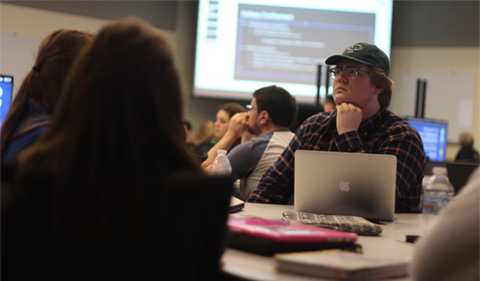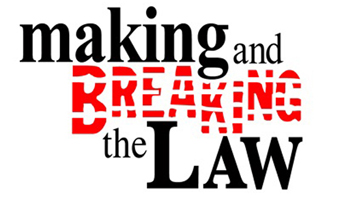
CAS 2500 Breaking the Law class
By Ashley Fishwick ’19
Eighty freshmen and sophomores met for a regular day of class in Schoonover 450. But this regular day of class on Sept. 29 was an unusual experience for undergraduate students at Ohio University.
CAS 2500: Breaking the Law is an innovative team-taught course that offers interdisciplinary approaches to the challenges of law and justice in the 21st century.
The course has four professors, no front-of-the-room podium, triangle desks for nine, and multiple screens to put everyone’s work on display.
Sponsored by the Center for Law, Justice & Culture, Breaking the Law is the gateway course for the Making and Breaking the Law theme. It prepares students for upper-division courses across Arts & Sciences that focus on law from a liberal arts perspective as well as high-impact programs that promote critical thinking beyond the classroom.
- Read more about the Law, Justice & Culture Certificate program.
- Read more about the spring break study abroad program Human Rights, Law & Justice in Northern Ireland.
- Read more about department honors thesis research on law, justice and culture.
Team-Taught Course ‘Really Opens Your Eyes’
The four-credit hour course is taught by Dr. Haley Duschinski, Associate Professor of Anthropology; Dr. Bruce Hoffman, Associate Professor of Sociology-Criminology; Dr. Rosemary Nagy, Associate Professor of Gender Equality and Social Justice; and Dr. Marina Peterson, Associate Professor of Performance Studies.
According to Ohio University sophomore Luke Schoeppner, this team-based learning is what makes the class so enjoyable.
“I really like the team taught aspect of the course,” said Schoeppner, who is intrigued by the topic of punishment and mass incarceration discussed in the class. “You can get the same information from different view points. It really opens your eyes.”
Prisons: ‘We See Systemic Overcrowding’
One of Schoeppner’s favorite topics was further discussed in class on the Sept. 29, when Hoffman, Director of Ohio University’s Sociology-Criminology program, lectured on mass incarceration.
According to Hoffman, changing attitudes toward crime in the 1970s sparked the mass incarceration seen in today’s society.
This change has lead to the warehousing of prisoners, illustrated through the architecture of prisons, compliance and retaliation mentalities, solitary confinement, and routine denial of medical and mental healthcare.
“We see systemic overcrowding,” Hoffman said. “The fascinating thing about today’s prisons are that the overcrowding is built in. It’s in the architecture.”
After speaking on these points, Hoffman turned the conversation over to the students, assigning them an in-class group activity to further engage the material.
Students were tasked with developing a presentation on medical provisions in California prisons and show the connections of these provisions to the class readings, which included an except from Coleman‐Plata v. Schwarzenegger (2009).
Group Activities Put Everyone on Screen
These group activities are aided via an innovative classroom structure.
Schnoonover 450 is a new high-tech classroom with student seating arranged around triangular tables, each connected to a large-screen monitor.
Students use the monitors to work on team projects at the tables. They project their work from their table monitors to one of three large projection screens in the corners of the room.
In contrast to traditional classrooms, Schoonover 450 does not have a front podium. For lectures and panels, professors talk while walking around the classroom, engaging with the students at their tables.
The classroom layout facilitates a more participatory approach to learning.
Dr. Haley Duschinski, Director of the Center for Law, Justice, and Culture, says the four instructors adapted the class to better take advantage of this unusual setup.
On Tuesdays, professors give lectures on the topics of the week, providing key frameworks to contextualize the readings.
Students then tackle these topics through group activities on Thursdays, working through the material to better understand the concepts.
Questioning Law and Justice
CAS 2500 raises a series of questions about law and justice in relation to citizenship, global affairs, human rights, public health, and science and technology.
CAS 2500 also goes beyond the classroom to help students better engage with these concepts and promote theme community among all Making and Breaking the Law faculty and students.
In this component, students are required to attend events throughout the semester such as public lectures, scholars and artists in residence, professional development seminars, film series, workshops, and reading groups.


















Comments